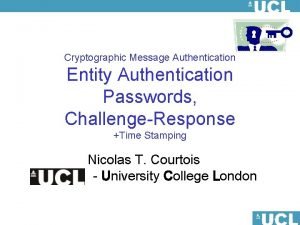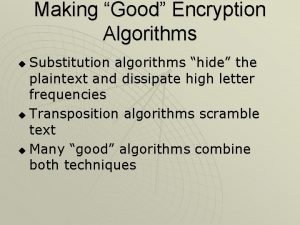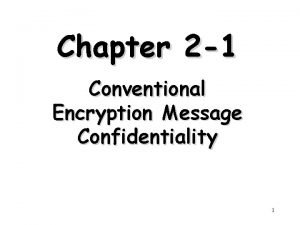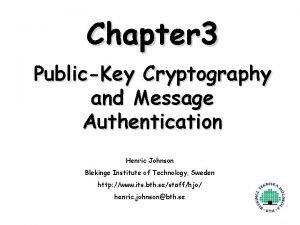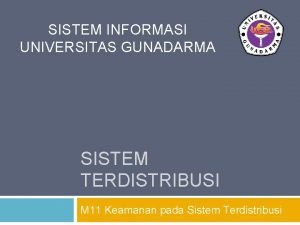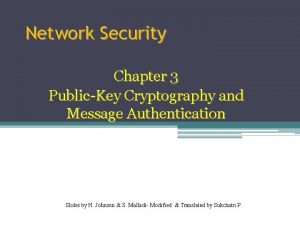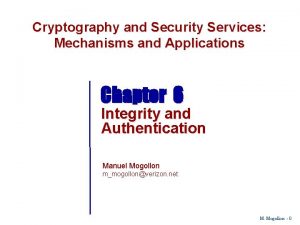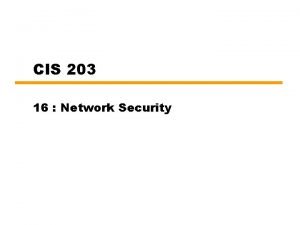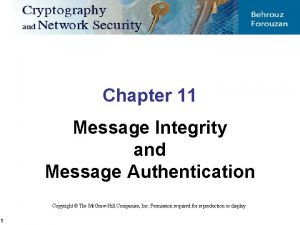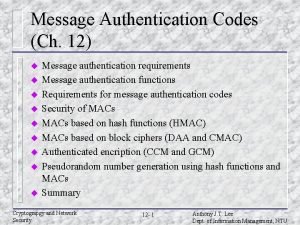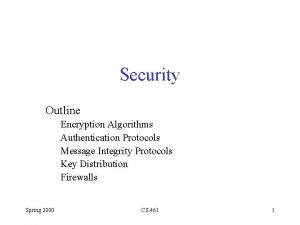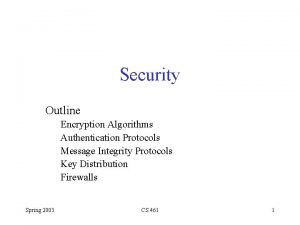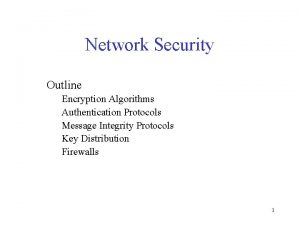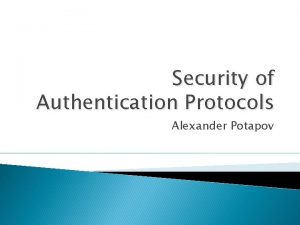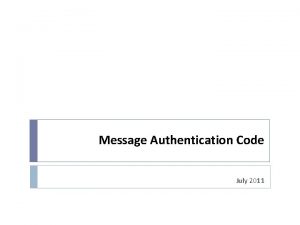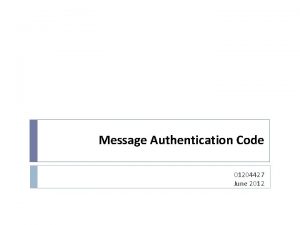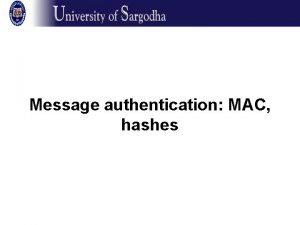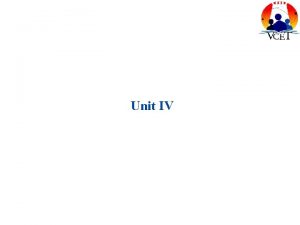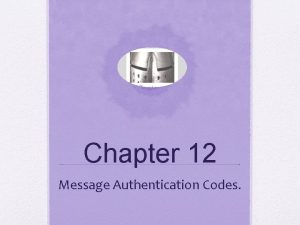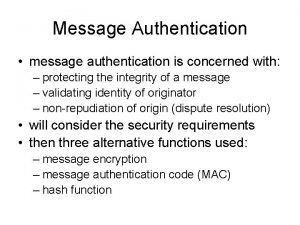Security Outline Encryption Algorithms Authentication Protocols Message Integrity















- Slides: 15

Security Outline Encryption Algorithms Authentication Protocols Message Integrity Protocols Key Distribution Firewalls 4/598 N: Computer Networks

Risk analysis • Important to understand threat and perform risk analysis – No system is “secure”, systems usually trade security for performance, ease of use etc. – If information is worth x and it costs y to break into system and if (x < y), then not worth encryption – Wasteful to build a system that is more secure than is necessary • Network data is transient (unlike stored data) 4/598 N: Computer Networks

End-to-end argument • End-to-end argument is appropriate for building a secure system – Perform security at lower levels if simple and does not impact performance – Higher levels usually know best regarding data integrity requirements Mobile device Should this link be encrypted? Server Access Point 4/598 N: Computer Networks

Security Attacks • Social engineering attacks – Preys on people gullibility (good nature), hardest to defend • E. g. I once got an unlisted number from a telephone operator because I sounded desperate (I was, but that was not the point) • E. g. Anna kour*va virus • E. g. If I walk in with coupla heavy looking boxes into the elevator to go to Boyd 5 th floor (at night) would you let me in? You can go into “secure” companies by looking like you “belong” there • Denial of service attacks – Network flooding, Distributed DOS, holding resources, viruses 4/598 N: Computer Networks

Overview • Cryptography functions – Secret key (e. g. , DES) – Public key (e. g. , RSA) – Message digest (e. g. , MD 5) • Security services – Privacy: preventing unauthorized release of information – Authentication: verifying identity of the remote participant – Integrity: making sure message has not been altered Security Cryptography algorithms Secret key (e. g. , DES) Public key (e. g. , RSA) Security services Message digest (e. g. , MD 5) Privacy 4/598 N: Computer Networks Authentication Message integrity

Encryption methods • Symmetric cryptography – Sender and receiver know the secret key (apriori ) • Fast encryption, but key exchange should happen outside the system • Asymmetric cryptography – Each person maintains two keys, public and private • M Private. Key(Public. Key(M)) • M Public. Key (Private. Key(M)) – Public part is available to anyone, private part is only known to the sender – E. g. Pretty Good Privacy (PGP), RSA 4/598 N: Computer Networks

Secret Key (DES) Plaintext Encrypt with secret key Decrypt with secret key Ciphertext 4/598 N: Computer Networks

• 64 -bit key (56 -bits + 8 -bit parity) • 16 rounds • Each Round Initial permutation Round 1 Li – 1 Ri – 1 F Round 2 56 -bit key … + Li Round 16 Final permutation 4/598 N: Computer Networks Ri Ki

• Repeat for larger messages IV Block 1 Block 2 Block 3 Block 4 + + DES DES Cipher 1 Cipher 2 Cipher 3 Cipher 4 4/598 N: Computer Networks

RSA • Named after Rivest, Shamir and Adleman – Only receiver receives message: • Encode message using receivers public key – Only sender could’ve sent the message • Encode message using sender’s private key – Only sender could’ve sent the message and only receiver can read the message • Encode message using receivers public key and then encode using our private key 4/598 N: Computer Networks

Strength • Strength of crypto system depends on the strengths of the keys • Computers get faster – keys have to become harder to keep up • If it takes more effort to break a code than is worth, it is okay – Transferring money from my bank to my credit card and Citibank transferring billions of dollars with another bank should not have the same key strength 4/598 N: Computer Networks

Public Key (RSA) Plaintext Encrypt with public key Decrypt with private key Ciphertext • Encryption & Decryption c = memod n m = cdmod n 4/598 N: Computer Networks

• • • RSA (cont) Choose two large prime numbers p and q (each 256 bits) Multiply p and q together to get n Choose the encryption key e, such that e and (p - 1) x (q - 1) are relatively prime. Two numbers are relatively prime if they have no common factor greater than one Compute decryption key d such that – d = e-1 mod ((p - 1) x (q - 1)) • Construct public key as (e, n) • Construct public key as (d, n) • Discard (do not disclose) original primes p and q 4/598 N: Computer Networks

My Public Key -----BEGIN PGP PUBLIC KEY BLOCK----Version: PGPfreeware 7. 0. 3 for non-commercial use <http: //www. pgp. com> m. QGi. BDqt. LPw. RBADn. G 0+9 Ik. Dv. I 8 t/3 wd. L 3 CSO 4 Dyt. EH 0 Njr. Nw. AYYIaewp 3 Mklsxk. P p 6 i. Vblwii. CH 4 T 4 Nqkaru+ka. EQ 1 h. STa 7 E/F 9 y. QCWN 5 J 0 u 1 U 7 mtg. TKFyt 7 VG 0 tx. AVx t. V 7 Tuyx. Nog. Jkpm 2 Bqo. Kqq. Ud. Cdbm+Gur. X/G 2 ynb. INj. EOvhcy 0 i 1 ttxgy. Drw. Cg/8 HZ t. M 0 i 06 VVNc. R/QCm. A+Jd. HGw. MEAIj. XLVV 97 hu. Etpu. WDiq 4 J 53 ec. V 3 HXQm 6 Xo. UZq 4 Sc n+nsv. Xe 4 UD+6 ldub/ri. Oq. By 22 f. BBAKh. Us. M 3 l. GFgr 7 h 19 X 3 RGdw/y. BVox+BLajp. W+ F+ddj. JAVSFe. Tv. Nanhn. XL 9 a 3 nw. CThb 4 a. EUTd. D 61 kgo. UWJl 2 Bns. K 1 DUSo 2 X 6 As. ZYo+ Gkn. OA/92 d. UNYUzsp. PLk. Xv. Pj. Oo+u. JEr. ZA 4 a. N+UYs. Jw. D 3 Al. Yug. VLkc 3 n. QBQy. SO 4 b. AR Xitjn. N 0 DA 6 Kz/j 6 e+cq. Re. Cy. Eu. Bn. Pta. Y/Nn/d. An 1 lg. Ul. J/Et. KQ 9 J 4 kr. I 3+Rx. Rmlp. Y Ut. Wy. Taak. V/QCXk. B/y. B 9 i 6 i. Afs. Cprlc. RSpm. ZAGu. NXr+p. HTHB 0 ILQm. U 3 Vy. ZW 5 k. YXIg Q 2 hhbm. Ry. YSA 8 c 3 Vy. ZW 5 k. YXJAY 3 Mud. Wdh. Lm. Vkd. T 6 JAFg. EEBECABg. FAjqt. LPw. ICw. MJ CAc. CAQo. CGQEFGw. MAAAAACgk. Ql. U 7 d. FVWfeisq. TACf. Xx. U 9 a 1 mbou. W 2 nb. Wdx 6 MHat. Q 6 TOg. Ao. M 9 W 1 PBRW 8 Iz 3 BIgcn. Ss. Z 2 UPNJHDu. QINBDqt. LPw. QCAD 2 Qle 3 CH 8 IF 3 Kiutap Qv. MF 6 Pl. TETl. Ptv. Fuu. Us 4 INo. Bp 1 aj. FOm. PQFXz 0 Af. Gy 0 Opl. K 33 TGSGSfg. Mg 71 l 6 Rf. U od. NQ+PVZX 9 x 2 Uk 89 PY 3 bzpnh. V 5 JZzf 24 rn. RPxfx 2 v. IPFRz. Bhznz. JZv 8 V+bv 9 k. V 7 H Aar. TW 56 No. KVy. Ot. Qa 8 L 9 GAFgr 5 f. SI/Vh. OSdv. NILSd 5 JEHNmszb. Dg. NRR 0 Pf. Iiz. HHxb LY 7288 kjw. EPwp. Vs. Yj. Y 67 VYy 4 XTj. TNP 18 F 1 d. Dox 0 Yb. N 4 z. ISy 1 Kv 884 b. Ep. QBg. Rj. Xy. E pwpy 1 ob. EAxn. IByl 6 yp. UM 2 Zafq 9 AKUJs. CRt. MIPWak. XUGfn. Hy 9 i. Usi. GSa 6 q 6 Jew 1 Xp Mgs 7 AAICCACLx. NC 3 Vth 553 Y 90 JCVy. M 9 m. PWzvrkjf. EGf. Bi. CFDZ 0 HONW 81 yw. Uy. V 6 j. T O/1 s. Usg. R 7 j. GB 26 XBsn. IY 96 a 9 WTp. Uo. I+20 Yst. FLRj 8 s. XOVXua. P/YTmg. SLv 82 O 6 SWd Bze 1 S 0 YJc. U 31/zd. Cftsz 67 UWT 8 vg 39 ye. Gy. Q 5 KQP 83 p 9 DKpi 4 Z 5 K 4 M 29 p 8 e. Ct 9 BY+ kid 94 h 9+16 ZT 8 JLF 0 i. Ew. Gap. Zvpa. Tuc. CNo. C 8 t 6 CKPto 0 d. Gpk. Yp 7 u. BYo. Sz. Lg. Nv. Uh 2 n Bj. GVEm. Luioabqb. Oaom. DEr. ITY 2 i. Nc. W 3 CCgjj. Yvgg/Hnu 7 HB 2 x. Kzu. VUN 1 NTGogcu. NI Yx 88 mi+d/Hx. TY 6 YNr 9 x. NW 0 f 0 p. Wk. ZDVB 0 i. QBMBBg. RAg. AMBQI 6 r. Sz 8 BRs. MAAAAAAo. J EJVO 3 RVVn 3 or. Yh. IAo. IQPx. Gv. Hm. X 8 c 6 ka. AZqko 1 z. YCeixc. AJ 9 tp 5 h/KQZr. IN/Bpy. TW 9 Xgv 4 qx. KEA== =Pv 5 O -----END PGP PUBLIC KEY BLOCK----- 4/598 N: Computer Networks

Public Key Infrastructure (PKI) • • Process of issuing, delivering, managing and revoking public keys E. g. Secure Sockey Layer (SSL) – Client C connects to Server S 1. C requests server certificate from S 2. S sends server certificate with Spublic to C 3. C verifies validity of Spublic 4. C generate symmetric key for session 5. C encrypts Csymmetric using Spublic 6. C transmits Csymmetric(data) and Spublic(Csymmetric) to S 4/598 N: Computer Networks
 Message authentication and entity authentication
Message authentication and entity authentication Code c
Code c Peer entity authentication definition
Peer entity authentication definition Making good encryption algorithms
Making good encryption algorithms Conventional encryption and message confidentiality
Conventional encryption and message confidentiality Approaches to message authentication
Approaches to message authentication Sistem terdistribusi gunadarma
Sistem terdistribusi gunadarma Message authentication code
Message authentication code Approaches to message authentication
Approaches to message authentication Message authentication is a service beyond
Message authentication is a service beyond Message authentication code
Message authentication code Ecb electronic signature
Ecb electronic signature Message authentication code
Message authentication code Message authentication code
Message authentication code Message integrity in cryptography
Message integrity in cryptography Message authentication functions
Message authentication functions
